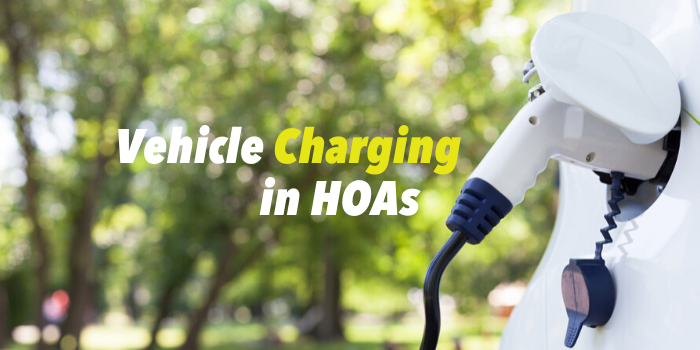The popularity of electric vehicles is rising, and with that comes the need for electric vehicle charging stations. In some states, such as California and Oregon, electronic vehicle owners are currently allowed to install an electric vehicle charging station in deeded or exclusive-use parking spaces. Homeowners in single-family home communities typically have the right to install personal charging outlets in their garages. But what about making vehicle charging stations available to your community as a whole?
There are several factors to be considered if the HOA is considering installing an EV charging station:
Do your research
Consult with residents and with your management company. Is this something a large majority of your residents want or need? If not, the cost and effort associated with installing EV charging stations may not be worth it until more residents require the service. If you do have a high or growing number of electronic vehicles in your community, then read on!
Know your needs
You must first know the different charging options to ensure that you are using the option that is most practical for your community. Level 1 is the simplest charging option – all you need is a standard 120-volt AC wall outlet. This is a low or no- cost option, as you may already have electrical outlets available in the parking garage or other community parking facility. If not, they may be installable for a reasonably small fee. Level 1 is a very slow charging process, which is generally good for overnight charging. Level 2 charging is preferred by most EV owners. This requires a professionally-installed unit, but is much faster, taking between 3 to 6 hours, depending on the vehicle. The downside is that the professional installation can cost upwards of several thousand dollars.
Consult professionals
The board and/or management company should meet with an electrical contractor who has experience with EV charging stations in order to understand the existing electrical capabilities of the existing infrastructure. This could affect which charging option makes the most sense, logically and financially, for your community.
Consider the costs
The association needs to have an idea of the costs associated with an Electric Vehicle charging station and must inform residents about what their expected contributions are. This includes both the installation costs and the running costs associated with the on-site charging station. Are you going to charge owners who have electric cars a flat fee for the installation, or is the association going to front the installation costs? Who is going to be responsible for the month-to-month electricity usage fees? The usage cost of an EV charging station is roughly a few hundred dollars per car, per year. Though it may not sound like much, it can add up, and needs to be accounted for. Many charging stations are set up so that users can simply charge their electricity to their own credit card, which is inserted at the station. For many, this is the preferable option. Another option is to use a meter to calculate who used the electricity, and then bill the owners of the respective vehicles.
Determine ownership and management
Ownership and management of the charging station is also an issue to consider. There are three basic ownership routes to consider: first, the charging station is owned and managed by the HOA; second, the charging station is owned and managed, for a fee, by an offsite company; or third, the charging station is owned by the association and managed by a third-party company. Each option has benefits and drawbacks, so it is important to thoroughly consider all options to ascertain which is best for your community.
Get approval
Before any installation can take place, the board (in most cases) must receive a favorable vote from the members of the association. Refer to your community CC&Rs to see exactly what is required in your specific situation.
Electronic vehicles are inevitably going to continue to grow in popularity, and those who own them will need a place to charge them. Even if your community isn’t affected by this need right now, you will likely have to address the issue in the near future, so keep this information in your back pocket until then!







